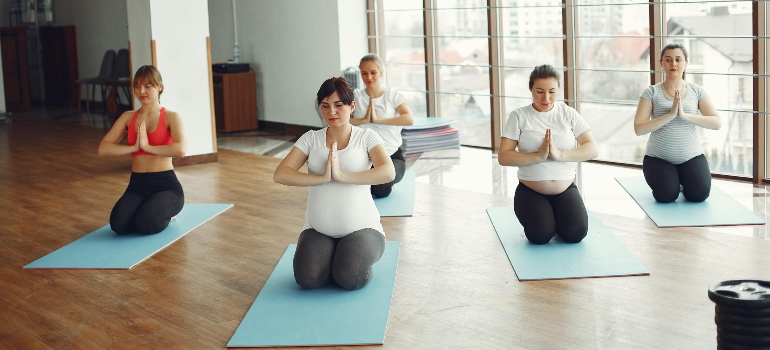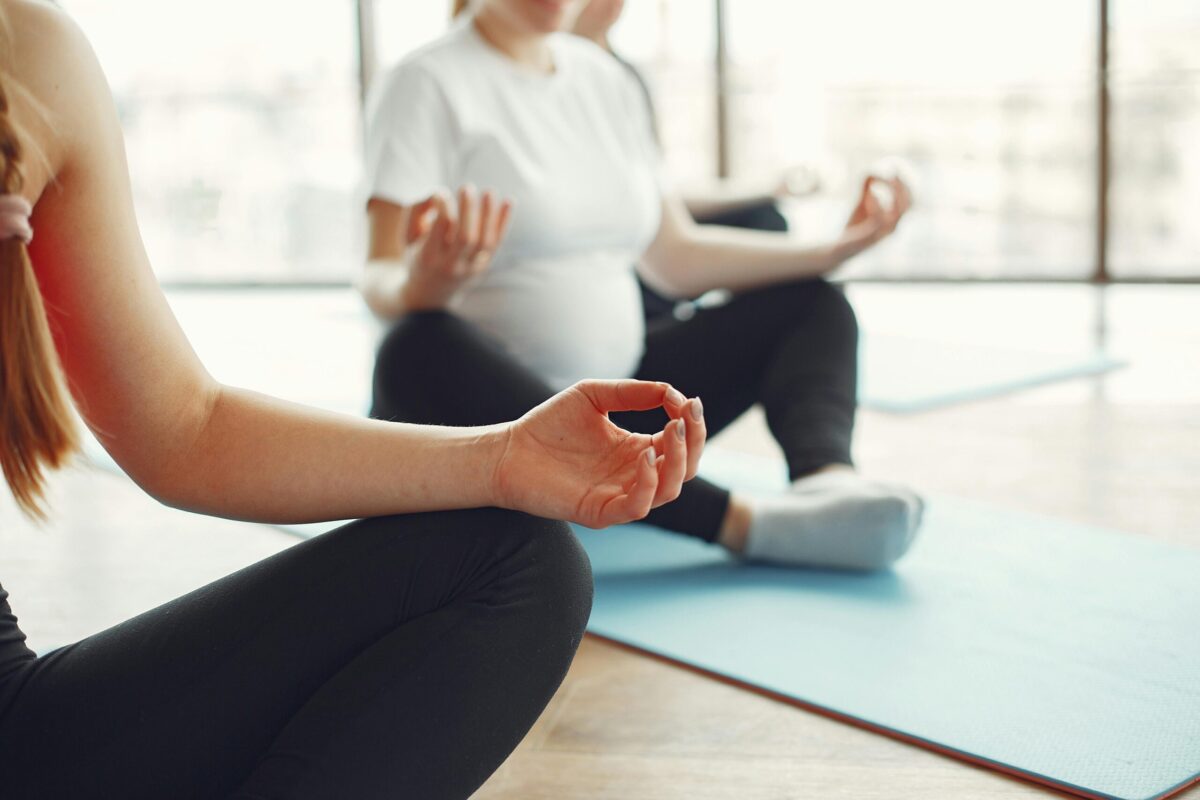Looking for a way to stay active during pregnancy? Prenatal yoga, which is specifically designed for expectant mothers, might be the ideal activity to incorporate into your routine due to its many benefits. With approval from your healthcare provider, staying active during pregnancy can greatly enhance your physical and mental well-being. In the UAE, where the climate and lifestyle can present unique challenges, prenatal yoga provides a safe and effective way for expecting mothers to stay fit, feel better and prepare for childbirth. This article will explore why the pre-natal yoga is important for expecting mothers in the UAE and how it can support you throughout your pregnancy journey.
Mental and Emotional Benefits of Pre-Natal Yoga
Prenatal yoga significantly helps reduce stress and anxiety, which are common during pregnancy due to hormonal changes and the anticipation of childbirth. Regular practice promotes mindfulness and relaxation through breathing exercises and gentle stretching, fostering a sense of calm and overall well-being.

One of the key benefits of prenatal yoga is improved sleep quality, a common challenge during pregnancy. Techniques like deep breathing and relaxation help reduce insomnia and enhance overall sleep patterns, helping expecting mothers feel rested. Additionally, prenatal yoga promotes emotional stability by balancing mood swings and alleviating symptoms of depression, leading to a more balanced emotional state.
To maximize these benefits, find a certified prenatal personal trainer in the UAE. They can tailor yoga practices to your specific needs, ensuring both safety and effectiveness. Look for trainers with prenatal care experience and positive reviews from other expectant mothers.
Building a Support Network
Participating in prenatal yoga classes in the UAE provides expecting mothers with essential social and community support. These sessions contribute significantly to mental and emotional well-being by fostering a sense of belonging and connection among pregnant women. The environment created in these classes allows mothers-to-be to share their experiences, challenges, and advice, creating a network of mutual support. This communal aspect is especially valuable in a diverse setting like the UAE, where individuals from various backgrounds can come together and bond over the shared journey of pregnancy.
Sharing experiences in these classes can be incredibly comforting and reassuring. Expecting mothers often discuss their feelings, ranging from excitement to anxiety, and receive empathetic feedback from others who understand their situation. This exchange helps to normalize the wide range of emotions that come with pregnancy, reducing feelings of isolation. Many women find solace in knowing they are not alone in their experiences and can draw strength from the collective wisdom of the group. This sense of solidarity and understanding can significantly enhance their overall prenatal experience, making them feel more prepared and supported throughout their pregnancy.
Enhance Physical Well-Being
Prenatal yoga classes in the UAE are specifically designed to address the needs of pregnant women at different stages of their pregnancy. Under the guidance of certified instructors, these sessions ensure that safety and comfort are prioritized. The exercises and techniques taught in these classes aim to improve physical well-being, focusing on strengthening the body, increasing flexibility, and promoting relaxation. This preparation is crucial for easing the discomforts of pregnancy and equipping the body for the demands of childbirth. By attending these classes, expectant mothers can maintain a healthy and active lifestyle throughout their pregnancy.
What Happens in a Prenatal Yoga Class?
A prenatal yoga class is designed to support the physical and emotional needs of expecting mothers. Here’s what typically happens in a session:
Warm-Up
Classes often start with gentle warm-up exercises to increase blood flow and prepare the body for more intensive movements. This can include light stretching and breathing exercises to help center the mind and body.
Breathing Techniques
Instructors guide participants through various breathing techniques (pranayama) that promote relaxation and can be useful during labor. These exercises help in managing stress and maintaining calmness throughout pregnancy.
Yoga Poses (Asanas)
The main part of the class involves performing specific yoga poses tailored for pregnancy. These poses focus on:
- Strengthening: Building strength in key areas like the pelvic floor, legs, and back.
- Flexibility: Enhancing flexibility, particularly in the hips and pelvis, to prepare for childbirth.
- Balance: Improving balance and stability as the body’s center of gravity shifts.
- Comfort: Modifications are made to ensure comfort and safety, avoiding any poses that could strain the body or restrict blood flow.
- Pelvic Floor Exercises: Specific exercises aimed at strengthening the pelvic floor muscles, which support the uterus, bladder, and bowels, and play a crucial role in childbirth and postpartum recovery.
Relaxation and Meditation
The class typically ends with a relaxation phase, which may include guided meditation or visualization techniques. During this time, instructors lead participants through calming exercises that focus on deep breathing and mental imagery. These practices help reduce stress, lower blood pressure, and promote a sense of well-being. The meditation often encourages a deep connection between mother and baby, fostering a sense of peace and emotional balance.
Cool-Down
Following the relaxation phase, the cool-down period involves gentle stretches and relaxation poses that help the body transition from the active part of the class to a state of rest. These stretches are designed to gently ease any muscle tension, improve circulation, and promote flexibility. This period allows mothers-to-be to absorb the benefits of their practice fully, helping to maintain an overall sense of well-being and prepare them for the rest of their day.

How to Stay Safe?
To ensure a safe and beneficial prenatal yoga experience, it’s essential to follow specific guidelines. Here are some key tips to help expectant mothers practice yoga safely:
- Qualified Instructors: Certified instructors experienced in prenatal care lead classes, ensuring exercises are safe and effective for each pregnancy stage.
- Personalized Modifications: Yoga poses are modified for comfort, focusing on gentle stretches and breathing techniques that reduce stress and enhance relaxation.
- Controlled Environment: Classes are often held in climate-controlled indoor settings, providing comfort in the UAE’s high temperatures.
- Medical Clearance: Consult with a healthcare provider before starting any prenatal yoga program to ensure it is safe based on individual health conditions.
These safety measures and personalized approaches help expectant mothers manage pregnancy-related discomforts and prepare for childbirth effectively.
What Trimester Should You Do Prenatal Yoga?
Prenatal yoga can be beneficial at any stage of pregnancy, but it’s important to adapt the practice to each trimester for maximum safety and effectiveness.
First Trimester
Many women begin prenatal yoga in the first trimester to start building strength, flexibility, and a calm mind early on. However, this period often involves adjusting to the new physical and emotional changes, so gentle and restorative practices are recommended.
Second Trimester
This is often considered the ideal time to start prenatal yoga if you haven’t already. The risk of miscarriage decreases, and many women experience increased energy levels. Yoga during this trimester focuses on maintaining flexibility, strengthening the muscles used in childbirth, and alleviating common discomforts such as back pain.
Third Trimester
Prenatal yoga during the third trimester emphasizes preparing the body for labor and delivery. Classes often include poses that open the hips, strengthen the legs, and encourage optimal fetal positioning. Gentle stretching, breathing exercises, and relaxation techniques are also crucial to manage the physical and emotional demands of the final weeks of pregnancy.

Adaptation to UAE’s Climate and Lifestyle
Adapting to the UAE’s climate and lifestyle while practicing prenatal yoga is important for expectant mothers. The UAE’s hot, arid climate requires special considerations. Here are the strategies:
- Stay Hydrated: High temperatures and low humidity can cause dehydration. Drink plenty of water throughout the day, especially before and after yoga sessions.
- Choose Cooler Times: Schedule outdoor yoga sessions during cooler parts of the day, like early mornings or late evenings, to avoid extreme heat.
- Indoor Yoga Classes: Opt for indoor prenatal yoga classes in air-conditioned environments to ensure a comfortable and safe exercise space.
- Wear Appropriate Clothing: Wear lightweight, breathable, and loose-fitting clothing to stay cool and comfortable during yoga practice.
- Listen to Your Body: Pay attention to your body’s signals and avoid overexertion. Rest as needed and modify poses to ensure comfort.
- Stay Informed: Keep updated with local weather forecasts and air quality advisories, as dust storms (shamans) can occur and impact breathing.
Practicing prenatal yoga can be enjoyable and safe with these adaptations. Consider joining prenatal yoga classes in the UAE with certified instructors who understand the needs of pregnant women in this climate.
Pre-natal Yoga is Important for Expecting Mothers in the UAE
Pre-natal yoga is important for expecting mothers in the UAE as it addresses both physical and emotional well-being during pregnancy. This practice helps manage the unique challenges faced by pregnant women, especially in the UAE’s climate and lifestyle. You can attend a prenatal yoga class at a fitness center in the UAE or follow videos online. If possible, opt for an in-person class with a female fitness trainer in the UAE to ensure you are doing the moves safely; an instructor will be able to guide you and answer any questions you may have. Make sure to seek an instructor experienced in prenatal yoga to ensure the best and safest experience tailored to your needs.

